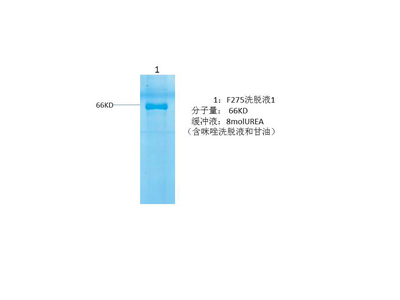- Home
- About
- Promotions
-
Products
-
Elisa Kits
- |
-
Primary antibodies
- |
-
Secondary antibodies
- |
-
Proteins
- |
-
IHC reagents
- |
-
WB reagents
- PonceauS Staining Solution
- PBST Washing Buffer, 10X
- 1.5M Tris-HCl Buffer, pH8.8
- 1M Tris-HCl Buffer, pH6.8
- 10% SDS Solution
- Prestained Protein Marker
- TBST Washing Buffer, 10X
- SDS PAGE Loading Buffer, 5X
- Stripping Buffered Solution
- Tris Buffer, pH7.4, 10X
- Total Protein Extraction Kit
- Running Buffer, 10X
- Transfer Buffer, 10X
- 30% Acr-Bis(29:1) Solution
- Tris电泳液速溶颗粒
- PBS(1X, premixed powder)
- TBS(1X, premixed powder)
- 快速封闭液
- 转膜液速溶颗粒
- Chemical reagents
- News
- Distributor
- Resources
- Contact
- Home
- >
- Info
- >
- c-Raf protein
- >
- Go Back
c-Raf protein
- Catalog No.:YD0119
- Applications:WB;SDS-PAGE
- Reactivity:Human
- Protein Name:
- c-Raf protein
- Sequence:
- Amino acid: 492-648, with his-MBP tag.
- Formulation:
- Liquid in PBS
- Concentration:
- SDS-PAGE >90%
- Storage Stability:
- -20°C/6 month,-80°C for long storage
- Other Name:
- RAF proto-oncogene serine/threonine-protein kinase (EC 2.7.11.1) (Proto-oncogene c-RAF) (cRaf) (Raf-1)
- Background:
- catalytic activity:ATP + a protein = ADP + a phosphoprotein.,cofactor:Binds 2 zinc ions per subunit.,disease:Defects in RAF1 are the cause of LEOPARD syndrome type 2 (LEOPARD syndrome-2) [MIM:611554]. LEOPARD syndrome is an autosomal dominant disorder allelic with Noonan syndrome. The acronym LEOPARD stands for lentigines, electrocardiographic conduction abnormalities, ocular hypertelorism, pulmonic stenosis, abnormalities of genitalia, retardation of growth, and deafness.,disease:Defects in RAF1 are the cause of Noonan syndrome type 5 (NS5) [MIM:611553]. Noonan syndrome (NS) is a disorder characterized by dysmorphic facial features, short stature, hypertelorism, cardiac anomalies, deafness, motor delay, and a bleeding diathesis. It is a genetically heterogeneous and relatively common syndrome, with an estimated incidence of 1 in 1000-2500 live births.,function:Involved in the transduction of mitogenic signals from the cell membrane to the nucleus. Part of the Ras-dependent signaling pathway from receptors to the nucleus. Protects cells from apoptosis mediated by STK3.,PTM:Phosphorylated upon DNA damage, probably by ATM or ATR. Phosphorylation at Thr-269 increases its kinase activity.,similarity:Belongs to the protein kinase superfamily. TKL Ser/Thr protein kinase family. RAF subfamily.,similarity:Contains 1 phorbol-ester/DAG-type zinc finger.,similarity:Contains 1 protein kinase domain.,similarity:Contains 1 RBD (Ras-binding) domain.,subunit:Interacts with Ras proteins; the interaction is antagonized by RIN1. Weakly interacts with RIT1 (By similarity). Interacts with STK3; the interaction inhibits its pro-apoptotic activity. Interacts with YWHAZ (unphosphorylated at 'Thr-232').,tissue specificity:In skeletal muscle, isoform 1 is more abundant than isoform 2.,
- Function:
- protein amino acid phosphorylation, phosphorus metabolic process, phosphate metabolic process, apoptosis,cytoskeleton organization, cell surface receptor linked signal transduction, enzyme linked receptor protein signaling pathway, transmembrane receptor protein tyrosine kinase signaling pathway, intracellular signaling cascade, small GTPase mediated signal transduction, Ras protein signal transduction, cell death, cell proliferation, programmed cell death, death, phosphorylation, nerve growth factor receptor signaling pathway,
- Subcellular Location:
- Cytoplasm. Cell membrane. Mitochondrion. Nucleus. Colocalizes with RGS14 and BRAF in both the cytoplasm and membranes. Phosphorylation at Ser-259 impairs its membrane accumulation. Recruited to the cell membrane by the active Ras protein. Phosphorylation at Ser-338 and Ser-339 by PAK1 is required for its mitochondrial localization. Retinoic acid-induced Ser-621 phosphorylated form of RAF1 is predominantly localized at the nucleus.
- Expression:
- In skeletal muscle, isoform 1 is more abundant than isoform 2.




